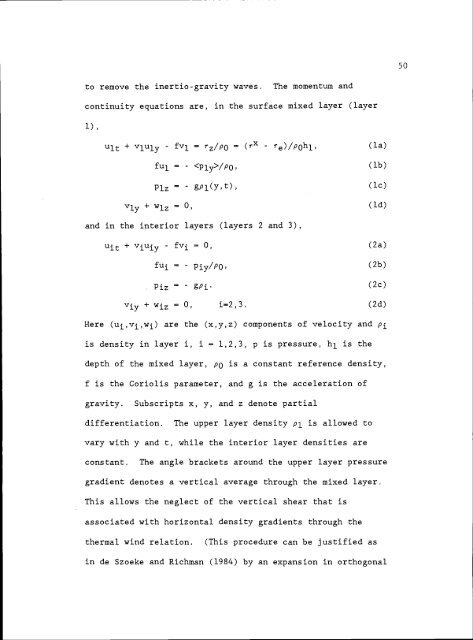Observations and Modelling of Fronts and Frontogenesis
Observations and Modelling of Fronts and Frontogenesis
Observations and Modelling of Fronts and Frontogenesis
Create successful ePaper yourself
Turn your PDF publications into a flip-book with our unique Google optimized e-Paper software.
to remove the inertio-gravity waves. The momentum <strong>and</strong><br />
continuity equations are, in the surface mixed layer (layer<br />
1),<br />
ult + Viuly - fv1 TZ/P0 = (TX re)/pOhl, (la)<br />
fu1 = /POi (lb)<br />
Plz = - gp(y,t),<br />
vly + wlz = 0,<br />
<strong>and</strong> in the interior layers (layers 2 <strong>and</strong> 3),<br />
(ic)<br />
(ld)<br />
uit + ViUiy fv 0, (2a)<br />
fui Piy/P0 (2b)<br />
Pjz = gpj. (2c)<br />
Viy + = 0, i=2,3. (2d)<br />
Here (ui,vi,wi) are the (x,y,z) components <strong>of</strong> velocity <strong>and</strong> Pj<br />
is density in layer i, i = 1,2,3, p is pressure, h1 is the<br />
depth <strong>of</strong> the mixed layer, P0 is a constant reference density,<br />
f is the Coriolis parameter, <strong>and</strong> g is the acceleration <strong>of</strong><br />
gravity. Subscripts x, y, <strong>and</strong> z denote partial<br />
differentiation. The upper layer density p is allowed to<br />
vary with y <strong>and</strong> t, while the interior layer densities are<br />
constant. The angle brackets around the upper layer pressure<br />
gradient denotes a vertical average through the mixed layer.<br />
This allows the neglect <strong>of</strong> the vertical shear that is<br />
associated with horizontal density gradients through the<br />
thermal wind relation. (This procedure can be justified as<br />
in de Szoeke <strong>and</strong> Richman (1984) by an expansion in orthogonal<br />
50















